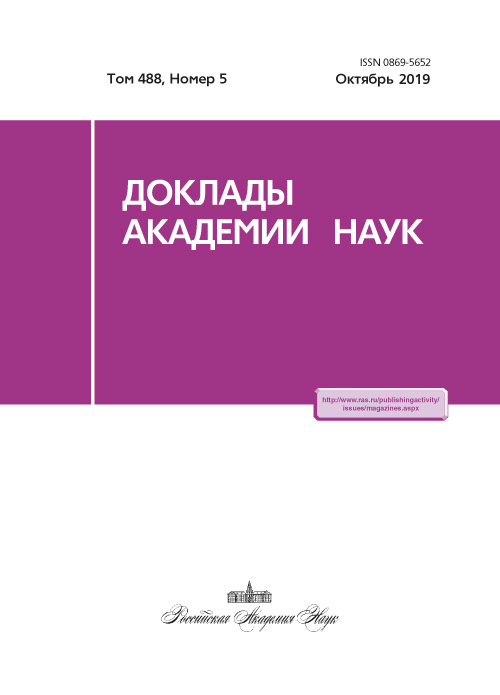The energy spectrum of the current velocity in deep layers of the Black Sea
- Authors: Klyuvitkin A.A.1, Ostrovskii A.G.1, Lisitzin A.P.1, Konovalov S.K.2
-
Affiliations:
- P.P. Shirshov Institute of Oceanology of the Russian Academy of Sciences
- Federal State Budget Scientific Institution Marine Hydrophysical Institute of the Russian Academy of Sciences
- Issue: Vol 488, No 5 (2019)
- Pages: 550-554
- Section: Oceanology
- URL: https://journals.eco-vector.com/0869-5652/article/view/17829
- DOI: https://doi.org/10.31857/S0869-56524885550-554
- ID: 17829
Cite item
Abstract
In 2016-2017, for the first time, nearly year-long measurements of the current velocities were carried out below the thermocline at a depth of 100 m and at a depth of 1700 m that was about 100 m above the seabed by using the mooring station in the deep central part of the Black Sea. Analysis of the new data set allowed us to uncover the followings. In the near-bottom layer, the significant flow velocities were recorded, reaching a peak magnitude of 0.13 m/s. Near the frequency of 1·10-6 Hz, in the transition region of the energy spectrum, the spectral energy of the deep current was close to that observed in the same range in the subthermocline layer of the sea. In the range of balanced geostrophic motions, the energy spectrum had a slope of -2,8 that should be compared to a spectrum slope of -1,8 obtained for current below the thermocline. The regular strong horizontal currents were observed near the local inertial frequency fI. There was a “blue shift” of the inertial maximum up to 5% with respect to fI in the energy spectrum.
About the authors
A. A. Klyuvitkin
P.P. Shirshov Institute of Oceanology of the Russian Academy of Sciences
Author for correspondence.
Email: klyuvitkin@ocean.ru
Russian Federation, 36, Nakhimovskii prospect, Moscow, 117997
A. G. Ostrovskii
P.P. Shirshov Institute of Oceanology of the Russian Academy of Sciences
Email: klyuvitkin@ocean.ru
Russian Federation, 36, Nakhimovskii prospect, Moscow, 117997
A. P. Lisitzin
P.P. Shirshov Institute of Oceanology of the Russian Academy of Sciences
Email: klyuvitkin@ocean.ru
Academician of the Russian Academy of Sciences
Russian Federation, 36, Nakhimovskii prospect, Moscow, 117997S. K. Konovalov
Federal State Budget Scientific Institution Marine Hydrophysical Institute of the Russian Academy of Sciences
Email: klyuvitkin@ocean.ru
Correspondent Member of the Russian Academy of Sciences
Russian Federation, 2A, Kapitanskaya street, Sevastopol, 299011References
- Murray J. W., Top Z., Özoy E. // Deep Sea Res. A. 1991. V. 38. Suppl. 2. P. S663-S689.
- Korotaev G., Oguz T., Riser S. // Deep-Sea Res. II. 2006. V. 53. № 17-19. P. 1901-1910.
- Герасимова С.В., Лемешко Е.Е. В кн.: Системы контроля окружающей среды. Севастополь: МГИ НАН Украины, 2011. В. 15. С. 187-196.
- Маркова Н.В., Багаев А.В. // Мор. гидрофиз. журн. 2016. № 3. С. 26-39.
- Клювиткин А.А., Кравчишина М.Д., Русанов И.И. и др. // Океанология. 2018. Т. 58. № 4. Приложение (Декабрь 2018). С. S30-S32.
- Thomson D. J. // Proc. IEEE. 1982. V. 70. P. 1055-1096.
- Percival D.B., Walden A.T. // Cambridge University Press. 1993. 583 p.
- Wunsch C. // Bull. Amer. Meteorol. Soc. 1999. V. 80. P. 245-255.
- Морозов А.Н., Федоров С.В., Маньковская Е.В. // Океанология. 2018. Т. 58. № 5. С. 681-688.
- Jörn C., Ferrari R. // J. Phys. Oceanogr. 2013. 43. № 11. P. 2456-2474.
- Frankignoul C., Muller P. // J. Phys. Oceanogr. 1979. V. 9. № 1. P. 104-127.
- Ferrari R., Wunsch C. // Tellus A. 2010. V. 62. № 2. P. 92-108.
- Reznik G.M. // Ocean Dyn. 2018. V. 68. P. 987-1000.
- Richman J.G., Wunsch C., Hogg N.G. // Rev. Geophys. Space Phys. 1977. V. 15. № 4. P. 385-420.
- Новотрясов В.В. // Океанология. 1998. Т. 38. № 1. С. 64-67.
Supplementary files







